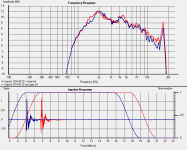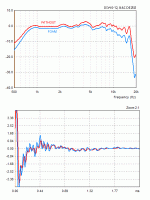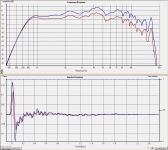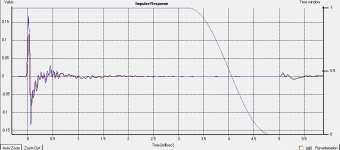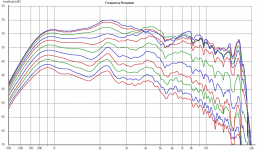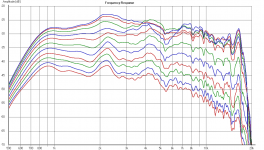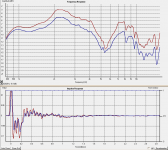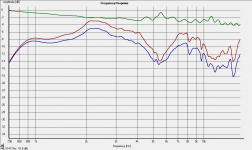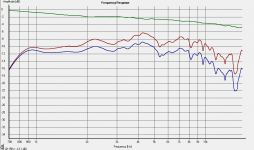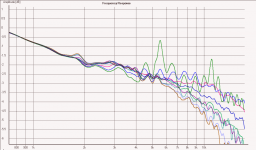Hi jzagaja,
IMO, attention to discrepancies like this can only add credence to the accuracy of the results.
Regards
Peter
Thanks for that Peter. Those are either really bad systems or really bad measurements. I use Holm regularly and those impulse responses are awful.
Hi Earl,
You may be thinking that the scale on the impulse response is linear, but it is a dB scale. I use the dB scale to make the first reflection easier to identify. Attached is the linear response. Sorry if this threw you off track. A question for you, how much more delay would you expect the foam would add to the start of the impulse response compared to an impulse response without foam ?
Regards
Peter
You may be thinking that the scale on the impulse response is linear, but it is a dB scale. I use the dB scale to make the first reflection easier to identify. Attached is the linear response. Sorry if this threw you off track. A question for you, how much more delay would you expect the foam would add to the start of the impulse response compared to an impulse response without foam ?
Regards
Peter
Attachments
I have no experience with foam plug but collected measurements from those who use Autotech OS waveguide. Enclosed please find data I've used for wavelet. This is not Dr. Geddes speaker but similar:
LoudspeakerSoft Forum / Geddes Loudspeakers clone
LoudspeakerSoft Forum / Geddes Loudspeakers clone
Attachments
jzagaja
Jack, I don't know what you've done with the data but you have wrong levels and maybe gating. This is more representative picture directly from Holm on my computer (raw gated data). The foam fills almost all of the waveguide volume. Honestly I can't remember if I had the time offset locked or not (I've forgotten to check that), so maybe the time scales are not comparable also.
I don't think you can see or say much from these measurements.
Marcel
Jack, I don't know what you've done with the data but you have wrong levels and maybe gating. This is more representative picture directly from Holm on my computer (raw gated data). The foam fills almost all of the waveguide volume. Honestly I can't remember if I had the time offset locked or not (I've forgotten to check that), so maybe the time scales are not comparable also.
I don't think you can see or say much from these measurements.
Marcel
Attachments
Last edited:
These are responses for "with foam" and "without foam" that I've measured on my attempt of OSWG. You can easily switch between them. It has all been measured from one point in space with and without foam for each angle. The only effect you can probably see is a slight attenuation, progressively increasing with frequency. It doesn't mean that there is nothing more - only that it's all these pictures can tell you. You can see 1/12oct smoothed version of this same data on my web.
Attachments
Last edited:
Jack, I don't know what you've done with the data but you have wrong levels and maybe gating.
Data from Holmimpulse exported (1024 samples) to wav file and imported into ARTA.
Hey, people just don't respect your IP. I let the patent expire for this reason and now its public domain.
a good one !
Michael
Not exactly - dampening materials have a sonic pattern of their own - a point that quite often is missed and (to my knowledge) not really well understood among audio guys
Michael
A sound of its own? You probably don't mean something in a linear sense, as that could be EQ'ed. Please explain.
I am disappointed by your arrogant and sarcastic attitude - an attitude I can't remember to have seen from you before. The way I see it, a forum serves to increase collective knowledge and I was hoping that I might learn something from you in this thread. Too bad, I seem to have misjudged you.
You are right my tone wasn't "the best one" - my apologies.
Besides that, I *may* come up with some ideas to the topic - but its not the place here for "in depth discussion" about sonics of dampening materials as Earl does not seem to see this of any relevance for him.
Strange enough, as dampening - and especially dampening of CMP effects (echo and looped echo) are playing a monumental role in audio.
Only few audio designs usually do not use any - "traditional" horn / waveguide / diffraction alignment device designs being one of them. One cold think that the dedicated horn sound lovers possibly share my outspoken aversion to dampening materials - without even knowing.
Earl, having "invented" or at least prominently popularized stuffing of horns (and thus IMO diluted "pure horn feeling") actually should have known that there is a sound wise trade off - but he seems not to be willing to enter this discussion.
Michael
PS
my question about what you did any different was not *only* arrogant...
Apologies accepted. If Earl doesn't mind, I'd still like you to explain why dampening material has a 'sound of its own'. So let me ask you again, please explain!
I'll come back to you on that topic...
Michael
Much appreciated!
As promised - here you possibly find some first answers:
http://www.diyaudio.com/forums/ever...-giant-leap-maturizing-audio.html#post2565176
Michael
PS
anybody be "warned" :
non of my findings are "peer reviewed" yet
LOL
Last edited:
It looks like the on axis notch between 5khz and 6khz is less deep with foam, so the foam has some good effect on the mouth/throat reflexions.These are responses for "with foam" and "without foam" that I've measured on my attempt of OSWG. You can easily switch between them. It has all been measured from one point in space with and without foam for each angle. The only effect you can probably see is a slight attenuation, progressively increasing with frequency. It doesn't mean that there is nothing more - only that it's all these pictures can tell you. You can see 1/12oct smoothed version of this same data on my web.
Hello !
Here I compared the posted IR with foam and without foam, using my new wavelet analysis package:
http://dl.dropbox.com/u/2400456/html/Elias_Pekonen/Wavelet_software.html
Here's a constant Q wavelet comparison:
And here's the same with amplitude normalised to better compare the temporal effects:
It seems that the foam is making the waveguide impulse response worse !
Am I the only one to see this !?
- Elias
Actually, I just wanted to see the extent of the performance improvement. Nothing more, nothing less.
David
To actually see "performance improvement" versus detrimental effects of damping materials - first hand those detrimental effects have to be characterized.
This, to my knowledge has not been done so in the past, though "everybody knows" and there is lots and lots of "anecdotal evidence" available
Michael
You can eventually study the impulses reponses given in the posts:
http://www.diyaudio.com/forums/multi-way/103872-geddes-waveguides-514.html#post2555612
http://www.diyaudio.com/forums/multi-way/103872-geddes-waveguides-514.html#post2555957
Best regards from Paris, France
Jean-Michel Le Cléac'h
Here I compared the posted IR with foam and without foam, using my new wavelet analysis package:
http://dl.dropbox.com/u/2400456/html/Elias_Pekonen/Wavelet_software.html
Here's a constant Q wavelet comparison:
An externally hosted image should be here but it was not working when we last tested it.
And here's the same with amplitude normalised to better compare the temporal effects:
An externally hosted image should be here but it was not working when we last tested it.
It seems that the foam is making the waveguide impulse response worse !
Am I the only one to see this !?
- Elias
Am I the only one to see this !?
no wavelet - no seen ...
Earl no likes wavelet (no "peer reviewed" !!!)...
Michael
Last edited:
Is that Earl's specific foam application or a fixed foam density? That's a significant difference since Earl specifically found it necessary to use a specific foam application. In my use of felt and to some degree foam, the difference in response can be significant with different felt/foam.It seems that the foam is making the waveguide impulse response worse !
Am I the only one to see this !?
- Elias
Dave
I haven't had a chance to follow all of this carefully. Jack asked for a measurement of his OS12 waveguide with and without the foam. I had one of his waveguides at the time, along with some foam I had cut, 30 ppi reticulated foam as seen here:
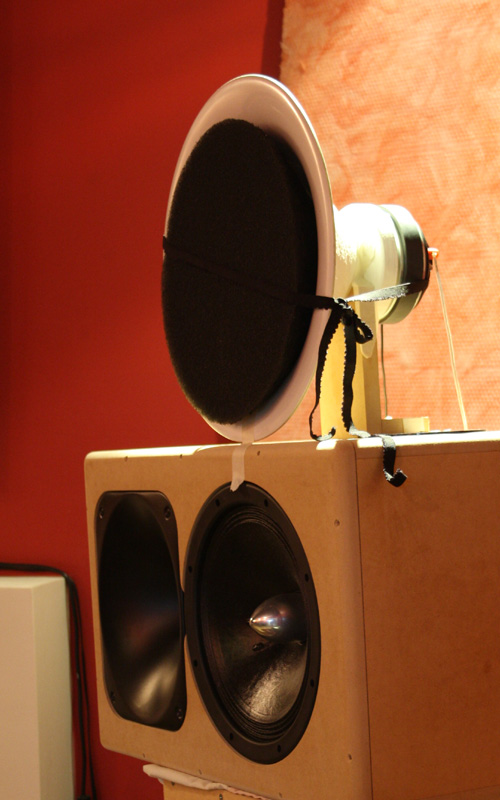
I was in a hurry and about to give the foam + waveguide back to its owner, so took a quick measurement with REW. I used REW as it could export the impulse response as a wave file. It was ungated and IIRC it was a nearfield, very close to the foam itself. It may have been an inch or two away. I had no idea what he intended to do with it and I also used some material not shown to hold the foam in place temporarily. I had to dispense with the first measurement of the foam, in which the material obscured the measurement and gave an uneven response which looked suspect. Having used the foam with 3 different waveguides, I knew something wasn't quite right. In each case, with 3 different waveguides of various sizes, the loss from the foam is 2db and quite consistent, and increases to 3 db above 10k.
I would be wary of basing too many conclusions on this measurement and to be honest I hope no one is basing too much on it. It's important to be sure that you have correct data before drawing conclusions. Had I known that this measurement would be analysed and scrutinised in this way, I would have taken it with a bit more care, in particular with a better method of holding the foam.
I have noticed an improvement with the foam, a significant reduction in harshness.
I currenly have running a 6" oblate spheroid waveguide with the same compression driver (DE250) and can take more measurements.

I was in a hurry and about to give the foam + waveguide back to its owner, so took a quick measurement with REW. I used REW as it could export the impulse response as a wave file. It was ungated and IIRC it was a nearfield, very close to the foam itself. It may have been an inch or two away. I had no idea what he intended to do with it and I also used some material not shown to hold the foam in place temporarily. I had to dispense with the first measurement of the foam, in which the material obscured the measurement and gave an uneven response which looked suspect. Having used the foam with 3 different waveguides, I knew something wasn't quite right. In each case, with 3 different waveguides of various sizes, the loss from the foam is 2db and quite consistent, and increases to 3 db above 10k.
I would be wary of basing too many conclusions on this measurement and to be honest I hope no one is basing too much on it. It's important to be sure that you have correct data before drawing conclusions. Had I known that this measurement would be analysed and scrutinised in this way, I would have taken it with a bit more care, in particular with a better method of holding the foam.
I have noticed an improvement with the foam, a significant reduction in harshness.
I currenly have running a 6" oblate spheroid waveguide with the same compression driver (DE250) and can take more measurements.
I currenly have running a 6" oblate spheroid waveguide with the same compression driver (DE250) and can take more measurements.
If you could share your new (foam non-foam) IR files here I would very much appreciate.
Please do not only take a measurements at the "mouth" but also one roughly at 1m distance on axis and at roughly 30deg (Earls target FR).
If you can do outdoor measurements, 2-3m distance would even be better - but its not really necessarily.
Michael
It looks like the on axis notch between 5khz and 6khz is less deep with foam, so the foam has some good effect on the mouth/throat reflexions.
Yes, you are right, there are some differences on axis.
Attachments
paulspencer;2565324 I have noticed an improvement with the foam said:Yup, in my experience the sonic effect of the foam far outweighed the modest attenuation. This was also true for a listener who found the foam dubious... until the before/after testing.
- Home
- Loudspeakers
- Multi-Way
- Geddes on Waveguides
